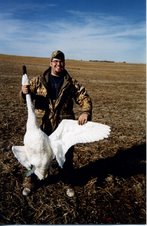
Never say never, when it comes to hunting Canada geese in the great state of Minnesota. Between Sept. 1 and Dec. 23rd there are only a handful of days when you cannot legally hunt Canada geese somewhere in Minnesota. That is something you can hang your hat on, Minnesota has plenty of geese and opportunities to hunt them.
The first time I went field hunting for Canada geese was in Rochester, MN. I was not even old enough to use a gun but I tagged along with my father and Dean Tlougan, owner/operator of Premier Flight guide service to a permanent pit-blind. We had supermag Canada goose shells in the cornfield, and it snowed. Canada geese were fooled and harvested that day.
Hunting Canada geese in snow filled cornfields is still one of my passions. Most weekends in December you can find me having breakfast before shooting-time at a particular McDonalds in Rochester, MN. There I will be discussing with others in camouflage, not only goose hunting, but whether or not 2 sausage burritos is as good as a single McSkillet burrito.
Historically Rochester has been the place to go to hunt late season Canada geese in Minnesota. Not only is it noted for the re-birth of the Greater Canada goose, or Branta Canadensis Maxima, the city also winters a large portion of the Canada geese from Manitoba.
There are many permanent pit-blinds found in the agricultural fields surrounding Rochester, MN. These pit-blinds are part of the history that comes from being an area that holds geese year after year. Pit-blinds are the most efficient way for hunters to be comfortable and concealed. Period.
When I hunt Canada geese in Rochester full-bodied decoys and excellent callers surround me. This makes for a deadly combination when the birds are flying off of the refuge to feed. Especially when it is cold and there is snow on the ground. The cold temps freeze up the smaller bodies of water and concentrate geese, while the snow causes the birds to lose a few IQ points.
Today Minnesota goose hunters can find geese any where from the Red River to the St. Croix. One does not have to travel very far in any direction to notice flocks of Canada geese flying somewhere in the distance. It is no mystery to the rest of the nation either; for some time Minnesota has led the country in total number of Canada geese harvested.
Lac Qui Parle refuge in Western Minnesota has been nationally known for it’s goose hunting for years, and it has continued to be that way. Recently the Canada goose limit has been raised from 1 bird to 2 birds in the West-Central zone. This has opened up more opportunities for goose hunters to experience hunting around Lac Qui Parle. In previous years, with large numbers of birds close to the Metro, it was hard to justify traveling all the way to Western Minnesota, just to be able to harvest a single goose.
With the mild winters Minnesota has been experiencing the last couple years there has been some lost opportunities due to a later migration. The regulations for the Minnesota 2007 Waterfowl season call for Canada goose hunting in the West-Central zone, the Lac Qui Parle area, to close on Nov. 27, with no late season. I assure you that there will be geese on the refuge well past that date, and I am okay with that. Remember, this article is about opportunity, which there is still plenty of.
I enjoy hunting Canada geese in the September early season, but I prefer to hunt geese later in the year in larger concentrations. Leaving for my home in St. Paul for a morning shoot it only takes me an hour and fifteen minutes to be in Rochester. That makes it the ideal place for a guy like me to focus my late season goose hunting efforts. Luckily my dad and I are still friends with Dean Tlougan, and he allows us to hunt with him and the rest of the Premiere Flight crew.
Most of the goose hunting I do before the weather starts making ice is pretty cut and dry. I scout, find where geese are feeding, obtain permission, and hunt them in the morning. Now that sounds way easier than it really is. For the majority of the hunting season scouting is the most important thing you can do. At the same time it is very costly and time consuming. By the time December roles around I am ready to jump into a heated pit-blind in Rochester. That is of course, following a breakfast at McDonalds.
For more information of hunting geese in Rochester check out www.goosegrinders.com or call Dean Tlougan at 507-252-5957.

